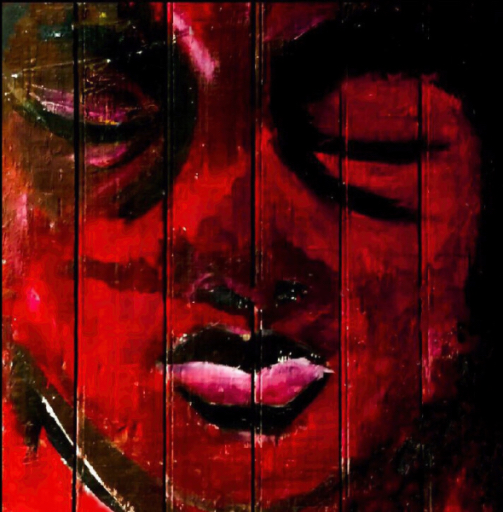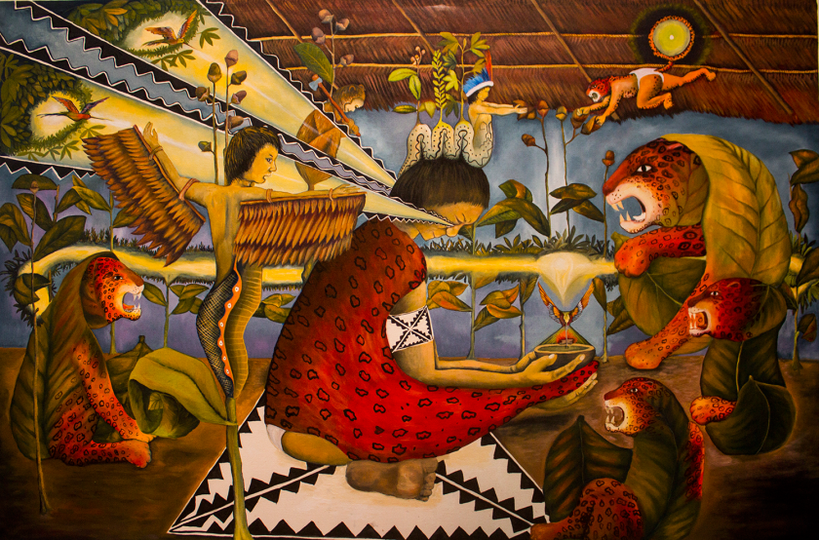Brus Rubio, “The Meditation,” a vision where the spiritual, the animal, and the natural environment connect on the same plane of consciousness. The artist transforms the ceremony into an image, intertwining symbolic and mystical elements, and reveals a universe where knowledge flows from the soul, the plant, and the jaguar.
Contemporary Indigenous Art
Tradition and Transformation
Contemporary Indigenous art from the Amazon reveals a far more complex and multifaceted dimension than the idealized images and stories of the legendary Amazon Rainforest.
Beyond the magic, the mystery, and the charm, another reality begins to emerge. It is deeper, more surprising, and more astonishing than it initially appears.
To truly grasp the essence of this art, one must enter a space of experience as alive, diverse, and mysterious as the rainforest itself. A world where artistic expressions unfold in two distinct yet deeply interconnected currents.
Contemporary Indigenous Art,
Created by artists belonging to Indigenous communities, whose work is grounded in ancestral knowledge, collective memory, and spiritual worldviews. And
Contemporary Amazonian Art
Created by non-Indigenous artists with a deep connection to the Amazon through lived experience, regional belonging, and artistic commitment.
Both artistic traditions share the same geographic origin, the vast Amazon Basin, an ecosystem that profoundly shapes the lives of its inhabitants. However, they arise from different cultural imperatives and artistic approaches.
The following text is dedicated to Contemporary Indigenous Art, exploring its distinct characteristics, motivations, and modes of expression. It demonstrates how the art of this region can expand our understanding of identity, creativity, and cultural resilience.
This essay engages with another dedicated to
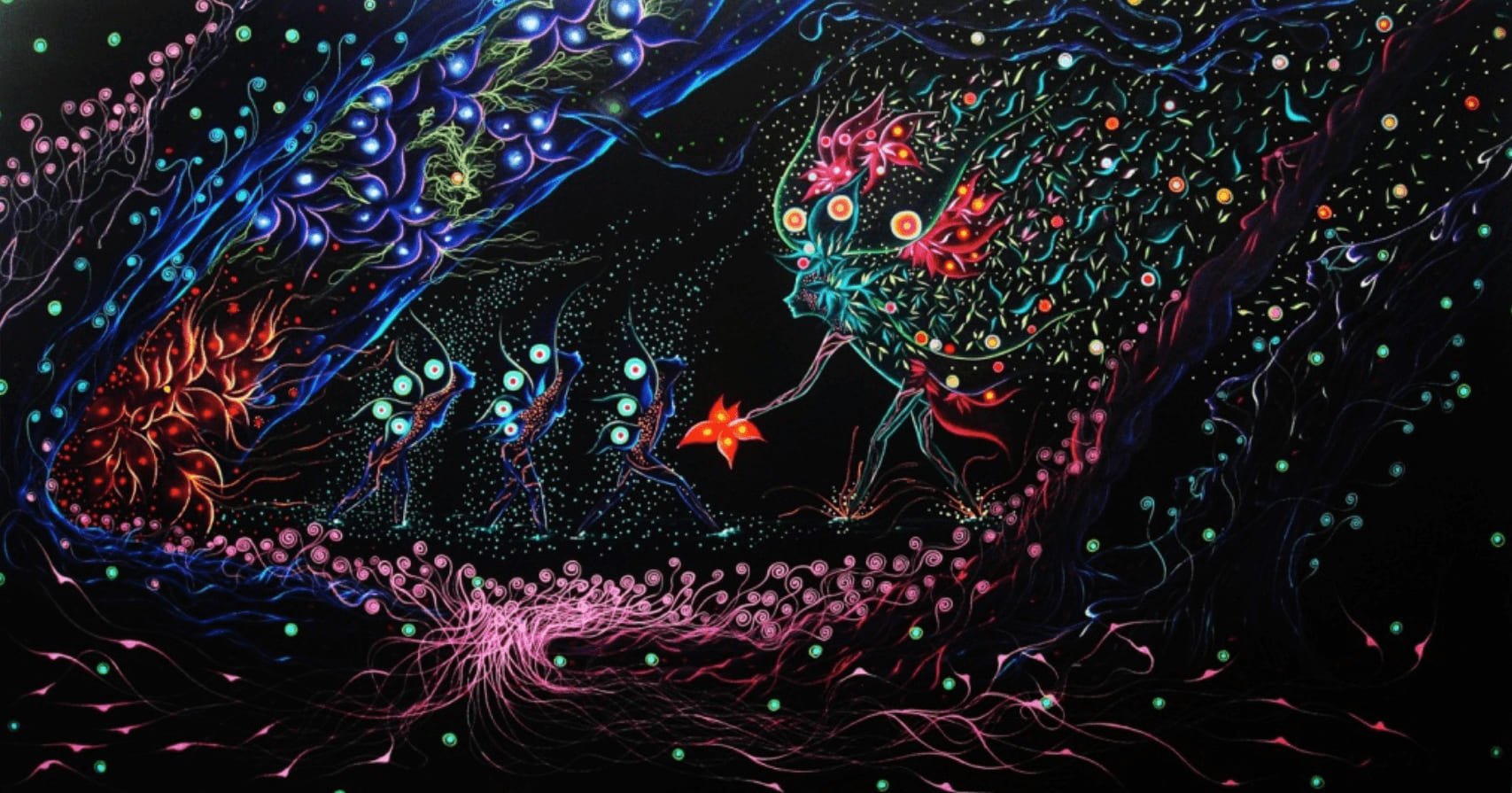
Rember Yahuarcani conveys a sense of deep connection with nature and spiritual forces, evoking ancestral traditions and mystical visions of the Amazon. Contemporary Indigenous Art.
Contemporary Indigenous Art: Cosmovision, Identity, and Cultural Survival
Legacy and Renewal — Carried by the Wisdom of the Ancestors
Amazonian Indigenous art, which bridges ancestral memory and contemporary expression, has multiple origins and faces. It reaches back thousands of years, beyond all written transmission. Yet it continues to live in the present: renewed, powerful, and intense.
Some of its traces can be followed back to ancient rock paintings. Others are created today on canvas or paper, sustained by the same spiritual connection to the world.
Traditional art is often a collective expression—a knowledge shared, passed down, and preserved across generations. However, individual artists are now emerging whose unique voices forge new paths. They expand and enrich the vision of Indigenous art beyond its ancestral origins.
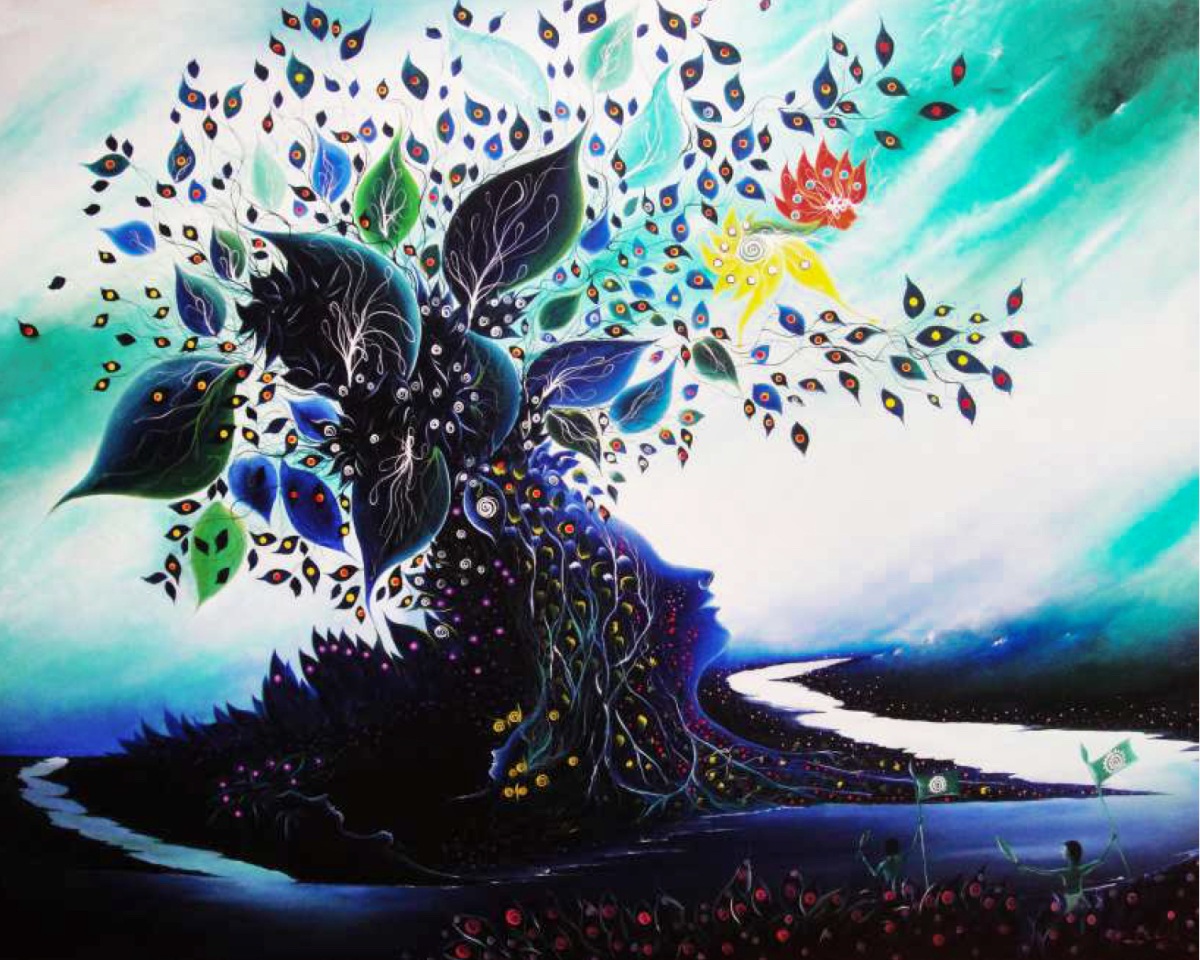
Remember Yahuarcani, “The Island” An expression of contemporary indigenous art that reveals the magic, memory, and vibrant spirit of the forest and its people. A river of ancestral voices and spirits, where the jungle becomes a being, the tree a blossomed thought, and the current a timeline that connects past and present. A deeply spiritual vision of heritage, identity, and continuity.
Key artist of the Huitoto people
Víctor Churay Roque – Ivá Wajyamu
“I don’t paint what I see, but what I feel. What comes to me in dreams or what the ancestors show me. The images don’t come from me – they come through me.”
Víctor Churay Roque, also known as Ivá Wajyamu (“the one who comes with the word”), was an exceptional Indigenous artist of the Huitoto people who gained international recognition in the 1990s. He is often regarded as a pioneer of a new generation of Indigenous artists — one that succeeded in merging ancestral worldviews with contemporary forms of expression.
His artistic inspiration originated from the knowledge of his ancestors. This was primarily passed down to him by his maternal grandfather, a Huitoto wise man and guardian of traditional knowledge. Through this familial access, Víctor inherited mythology, rituals, and a deep connection to spiritually significant plants. All of this nourished his visual universe directly. His paintings depict visionary scenes where cosmological concepts, spiritual beings, healing plants, and soul journeys converge.
A pioneer of contemporary Indigenous art
Ivá Wajyamu was the first Indigenous artist to exhibit his work not only in local contexts, but also internationally — in cities such as Bogotá, Paris, and Havana. In doing so, he opened the path for many others. He showed that Indigenous art is not merely to be preserved, but is capable of evolving — and of acting as a critical voice in the present.
Significantly, Ivá Wajyamu’s art did not originate in a studio — it emerged from the forest. It came from the heart of his community and the living memory of his people. His work was never a mere illustration of ancestral myths, but a living cosmovision made visible. It became an artistic response to colonial trauma, environmental threats, and questions of identity. In an interview, he described his art as a way of “turning his inner self outward.” For him, painting was both an act of healing and a cultural affirmation of his existence.
His paintings depict visionary scenes where cosmological concepts, spiritual beings, healing plants, and soul journeys converge.
Ivá Wajyamu passed away in 2002 under tragic circumstances. Yet he left behind a remarkable artistic legacy — one that remains deeply relevant to this day.
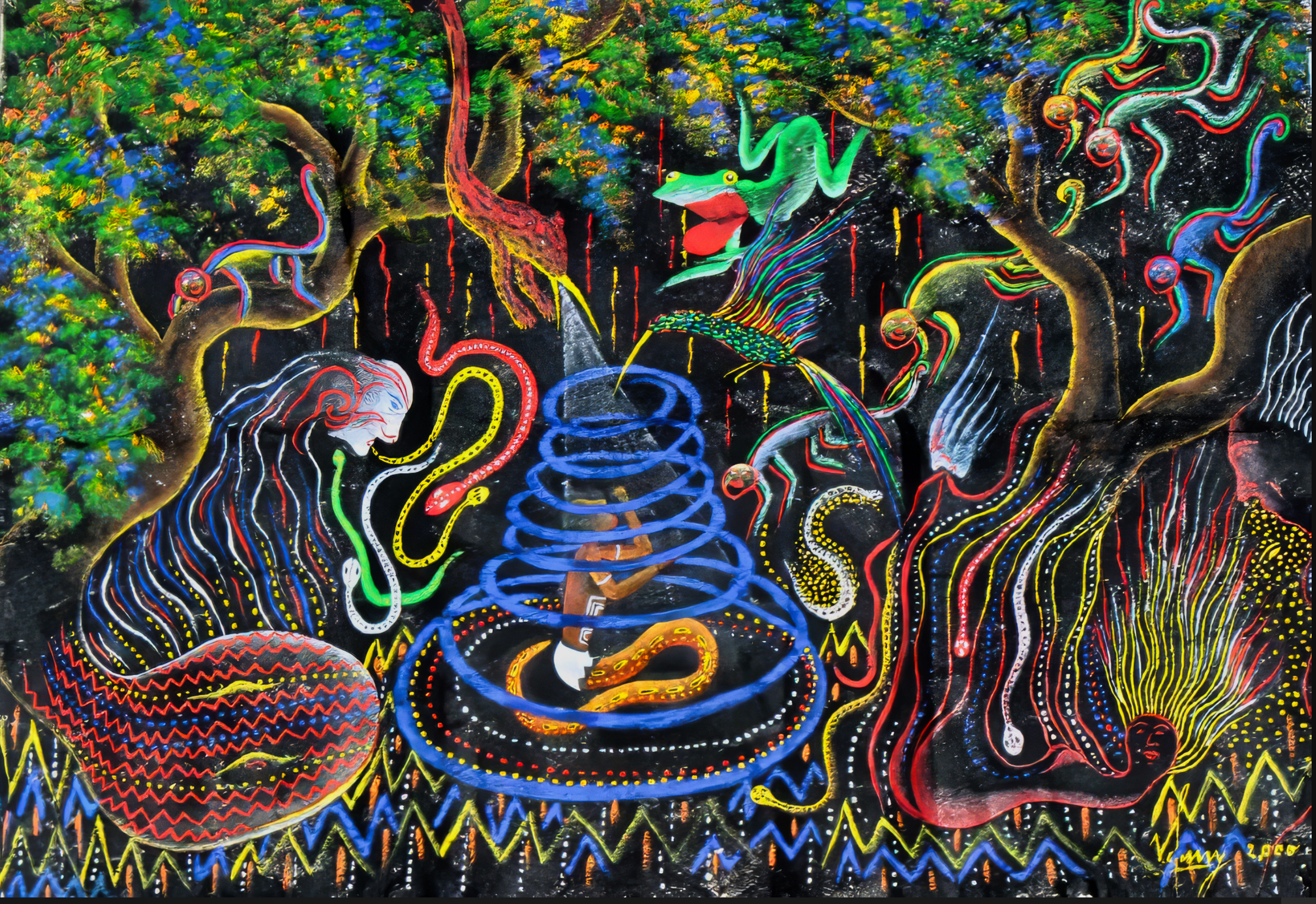
Victor Curay Roque, Visions
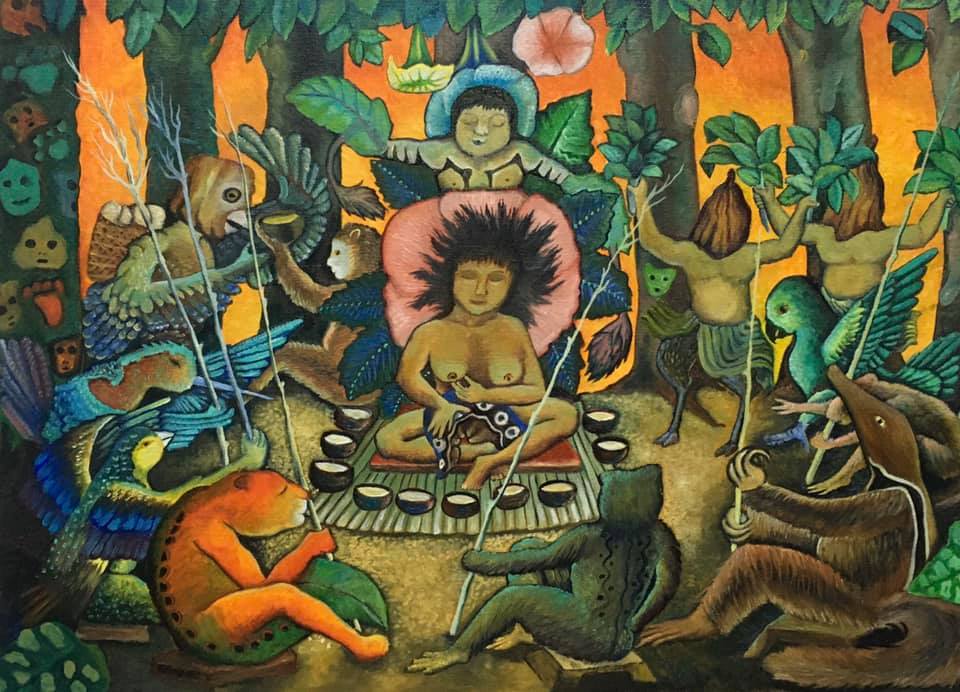
Brus Rubio, Bie isoi comuide
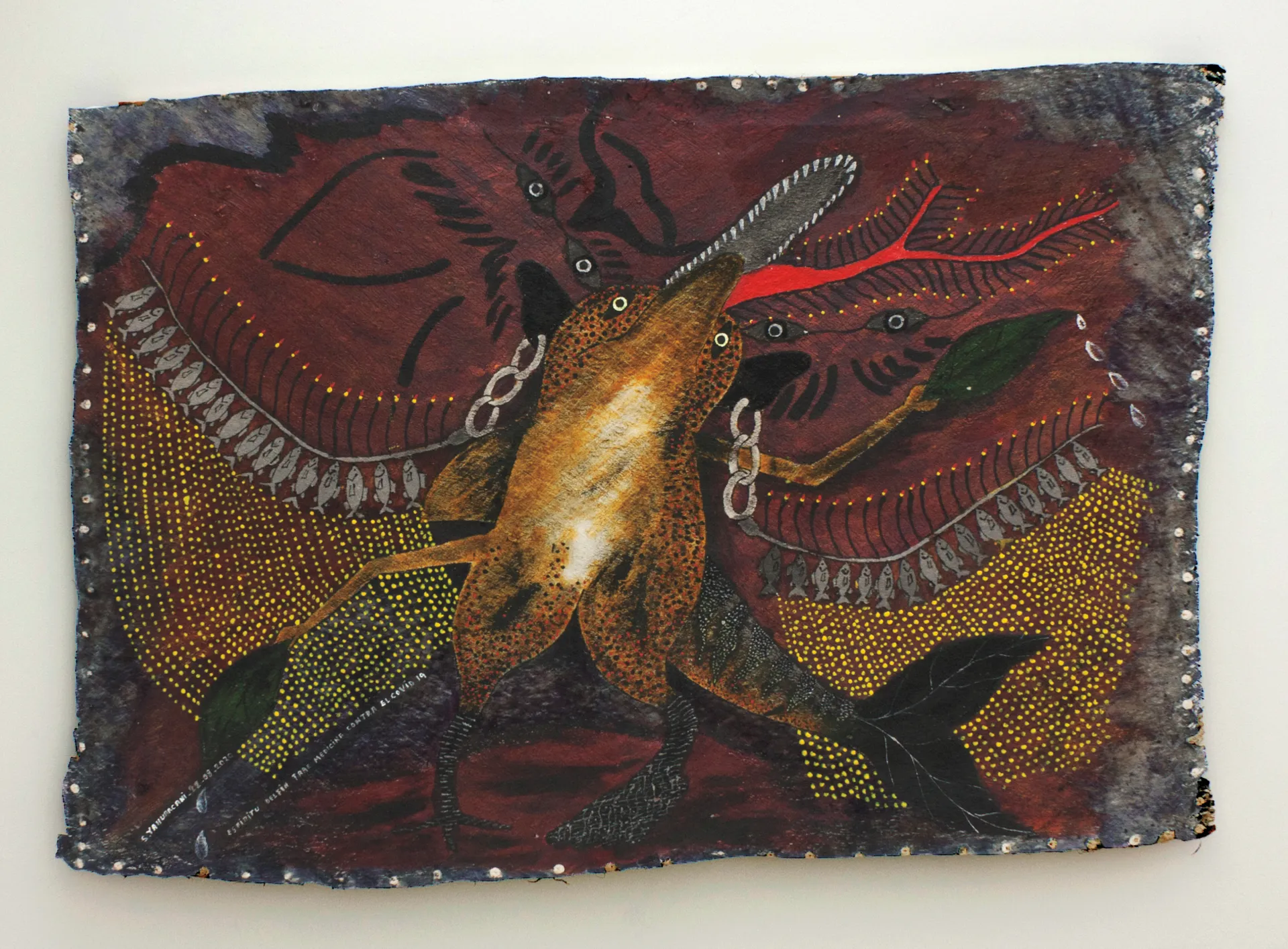
Santiago Yahuarcani, El espiritu del Delfin
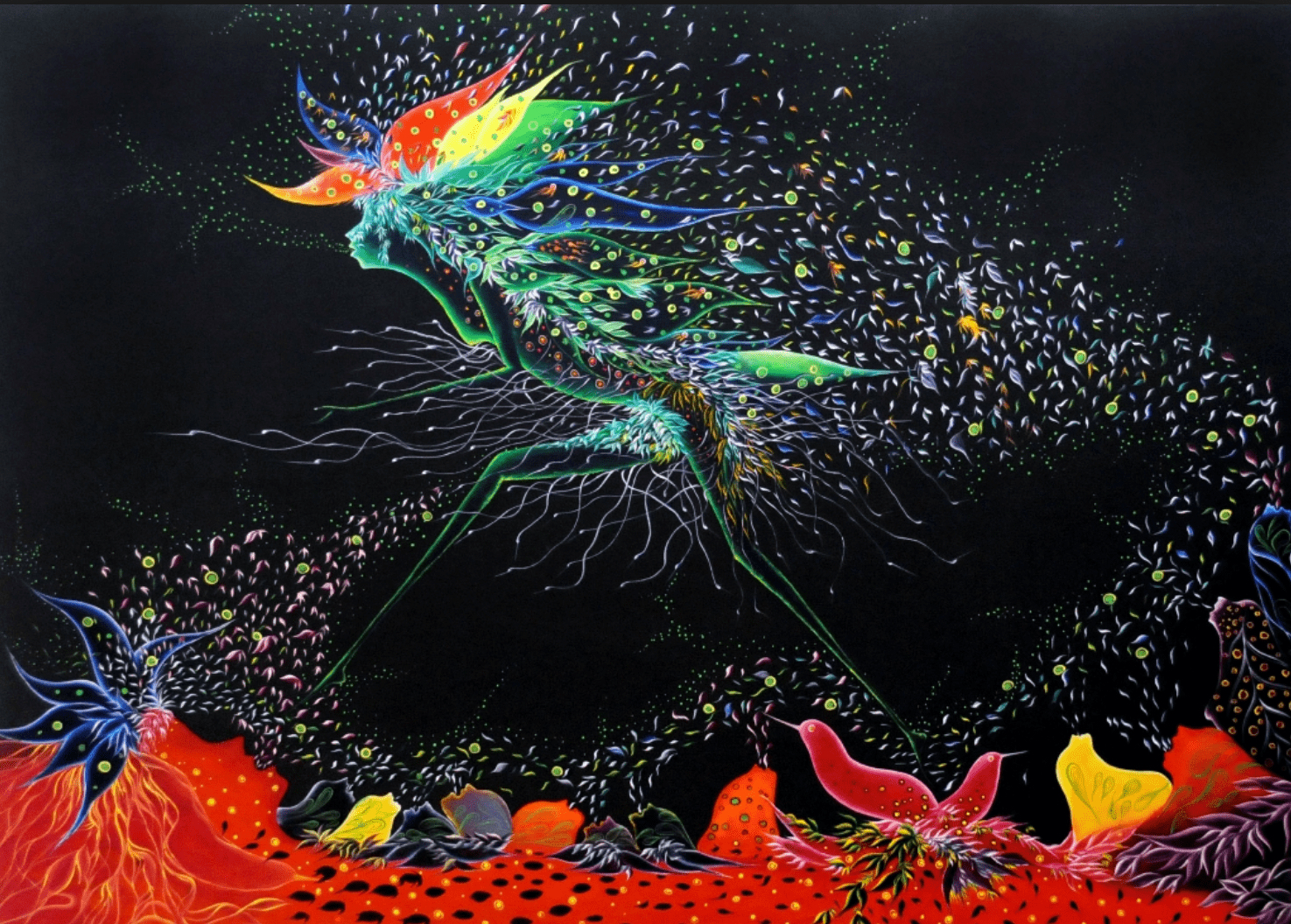
Rember Yahuarcani, Mural
An Ancestral Voice – Painter, Storyteller, and Guardian of Uitoto Memory
Santiago Yahuarcani
““There is a world distinct from the Western one, still waiting to be explored. People are only just beginning to know us… Hopefully, over time, we will manage to share it.”
A Canvas of Memory and Healing
Santiago Yahuarcani is one of the most renowned Indigenous artists in Peru. A member of the Uitoto people and the Clan of the White Heron, he is heir to a legacy of resistance, oral tradition, and collective memory. His work is deeply rooted in an Indigenous worldview, yet also shaped by the pain of a family history that lived through the atrocities of the rubber boom. His grandparents survived that horror, and that memory is the seed of his art.
Santiago’s painting is both testimony and reconstruction. His works speak of dispossession, colonial trauma, the loss of land and culture. But they also speak of what endures — of what is reborn. On his canvases, mythical beings, talking forests, water spirits, and the teachings of the grandfather come to life. These are not ethnographic illustrations, but visions that move between dream and history, between mourning and hope.
Yahuarcani’s visions form a living map of the soul. They invite us to recognize the hidden links between past and future. Ultimately, his work celebrates the strength of the spirit in a fractured world.
A key artist of contemporary Indigenous art.
Beyond visual language, Santiago Yahuarcani has built a bridge between oral tradition and contemporary art. His work has been exhibited in major institutions such as the Museo de Arte de Lima, the Reina Sofía Museum in Madrid, the Venice Biennale, and MoMA in New York — always carrying with him the voice of his community.
His paintings are a powerful reminder of the wounds history tries to silence: the pain of the rubber boom and the quiet resilience of collective memory. In each exhibition, he does not merely represent his culture — he reclaims it, questions it, and ultimately redefines it through a vision rooted in memory, lived experience, and resistance.
The voice of a people on the global stage
As an artist, a voice for his people, and a guardian of cultural memory, Santiago belongs to a generation that transforms contemporary Indigenous art into an act that is both political and poetic. In his works, it becomes a testimony of a past seen through Indigenous eyes.
His work challenges us deeply. It urges us to reflect on our identity and our relationship with history. These paintings do not seek to conform to Western expectations — they open other horizons. They invite us to see differently, to listen to the voices of the past and the memories of the forest.
Moreover, we must recognize that Indigenous art is not an exotic display. Instead, it’s a living and powerful instrument for defending dignity, recognition, and change. It’s art that narrates open wounds that haven’t yet healed, stemming from a dark, unprocessed history full of injustice and scars—yet, it’s also a voice that, from pain, creates beauty.
It is not the harmony of this art that moves us, but its truth. Its fascinating aesthetic convinces through its depth, strength, and significance. Recognizing Indigenous art and thought as part of the global avant-garde may lead us to a deeper understanding of this planet — and of our place within it.
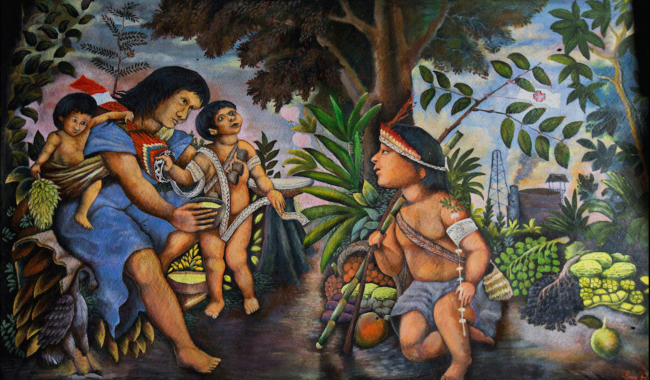
In El Heredero, Brus Rubio depicts a young Indigenous boy standing at the crossroads of tradition and progress, inheriting both ancestral wisdom and a world threatened by encroaching industry.
The Power of Indigenous Art: Healing, Remembering, Transforming
Contemporary Indigenous art is characterized by a diversity of voices. However, some figures stand out for having defined its direction and resonance. Notably, the pioneering vision of Víctor Churay, the ancestral depth of Santiago Yahuarcani, the spiritual universe of Rember Yahuarcani, and the mythical narrative of Brus Rubio Churay.
Beyond aesthetics, their work serves as a powerful vehicle for healing and the continuity of spiritual traditions. It also ensures the preservation of collective memory, which is crucial in the face of historical trauma caused by the rubber boom and the near-total collapse of Indigenous societies.
With unique approaches and rich imagery, these artists continue to influence the contemporary Indigenous art movement. Their art is profoundly rooted in tradition while remaining strikingly relevant today.
Guardians of the Amazon – Indigenous Artists and Their Legacy
Resistance, Cultural Continuity, and Spiritual Depth
Today, Indigenous painting has become a powerful tool for cultural preservation and political engagement. External cultural influences, such as deforestation and the exploitation of natural resources, exert constant pressure. In response, Indigenous artists use their works to affirm their identity and defend their ancestral territories. Through their art, they attract international attention and raise awareness about the environmental and human rights crises affecting the Amazon.
For millennia, the Indigenous peoples of the Amazon have expressed their cosmovisions through visually symbolic forms. Body painting, ceramics, textile art, feather headdresses, and rock paintings all play a central role. These are living expressions of their spirituality, historical memory, social organization, and deep connection with nature.
Visual Worldview: Art as a Spiritual Language
Contemporary Indigenous art from the Amazon is culturally significant because it not only preserves traditions but also actively contributes to its living renewal. It serves as a creative translation of inherited cosmovisions into new media and contexts. Crucially, it remains deeply connected to the cosmology, mythology, and community-held knowledge.
For many Indigenous artists, art is not merely an aesthetic expression; rather, it’s a sacred, living, and deeply community-rooted spiritual practice.
It functions as a visual language that makes visible their close relationship with nature: forest spirits, medicinal plants, and wisdom transmitted over generations. Within their works, symbolic patterns, colors, and figures appear, all bearing significant meaning deeply anchored in each community’s collective memory.
Ultimately, this art constitutes a visual legacy, an urgent call for justice, and a living testament to an unyielding resistance. It not only enriches global Indigenous visual culture but also contributes to critical debates on ecological consciousness, cultural self-determination, and artistic resistance.
“Tradition does not mean preserving the ashes,
but keeping the flame alive.”
Themes and Symbolism
A central and ever-present theme is the interconnectedness of all beings within the rainforest ecosystem. Animals are seen not only as living creatures but also often as spiritual entities, ancestors, or shape-shifters. Plants—especially those with medicinal or ceremonial importance—hold deep symbolic meaning.
Mythological stories—such as creation myths, epic journeys, and encounters with otherworldly spirits—are often depicted on the canvas. Furthermore, recurring geometric patterns emerge, such as the kené designs of the Shipibo-Conibo or the meticulous ornaments of the Kaxinawá/Huni Kuin. These are attributed with an energetic effect or represent visions experienced during ceremonies with sacred plants like Ayahuasca.
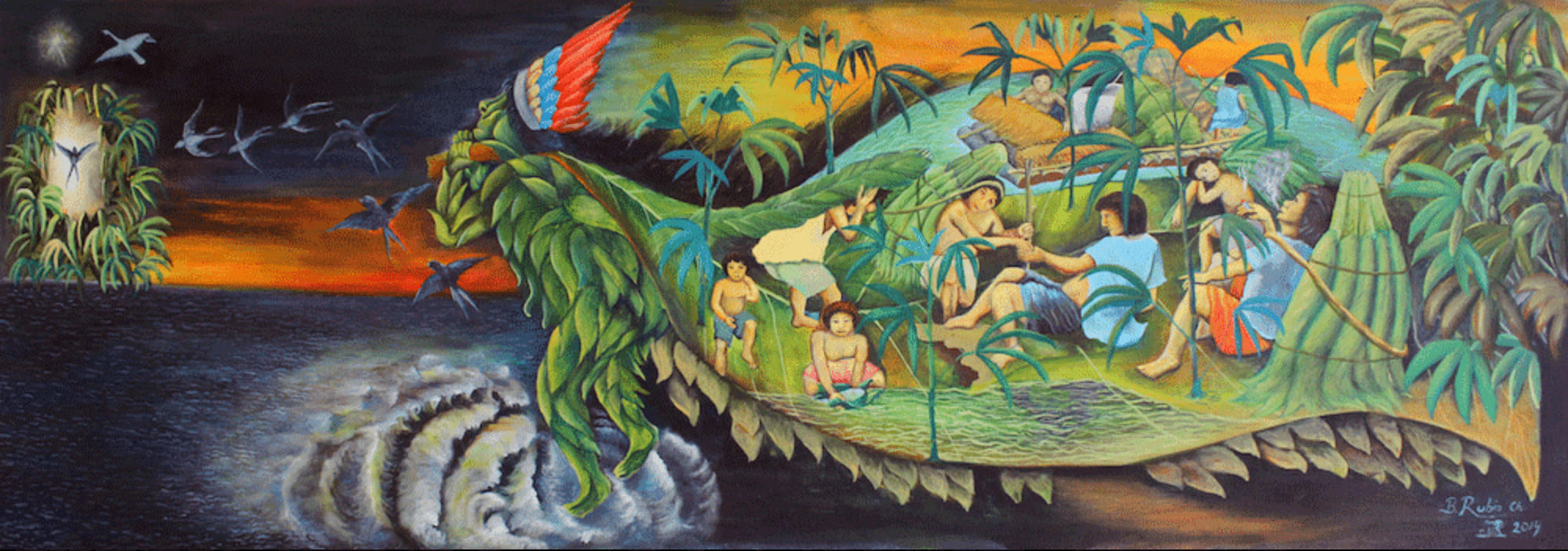
Brus Rubio’s “The Spiritual Guide” represents the deep connection between humans, nature, and the spiritual realm within Amazonian culture. The scene illustrates a cycle of life, protection, and ancestral wisdom passed down through generations. A space where the earthly and the celestial converge.
Materials and Techniques
Originally, Indigenous artists utilized natural pigments applied to bark, wood, or animal hides. Today, however, many contemporary painters are increasingly turning to modern materials like acrylics or oil paints, working on canvas. This shift enables them to create larger, more durable works capable of traveling across continents and reaching new audiences.
Despite the modern support, the underlying visual language remains deeply rooted in tradition. Lines and colors adhere to a symbolic vocabulary passed down through generations. While the brushstrokes may be contemporary, the stories they tell carry the ancestral knowledge.
Artists from communities such as the Huitoto, Shipibo-Conibo, and Asháninka are reactivating cultural memory with their works, giving ancient narratives new presence through current media.
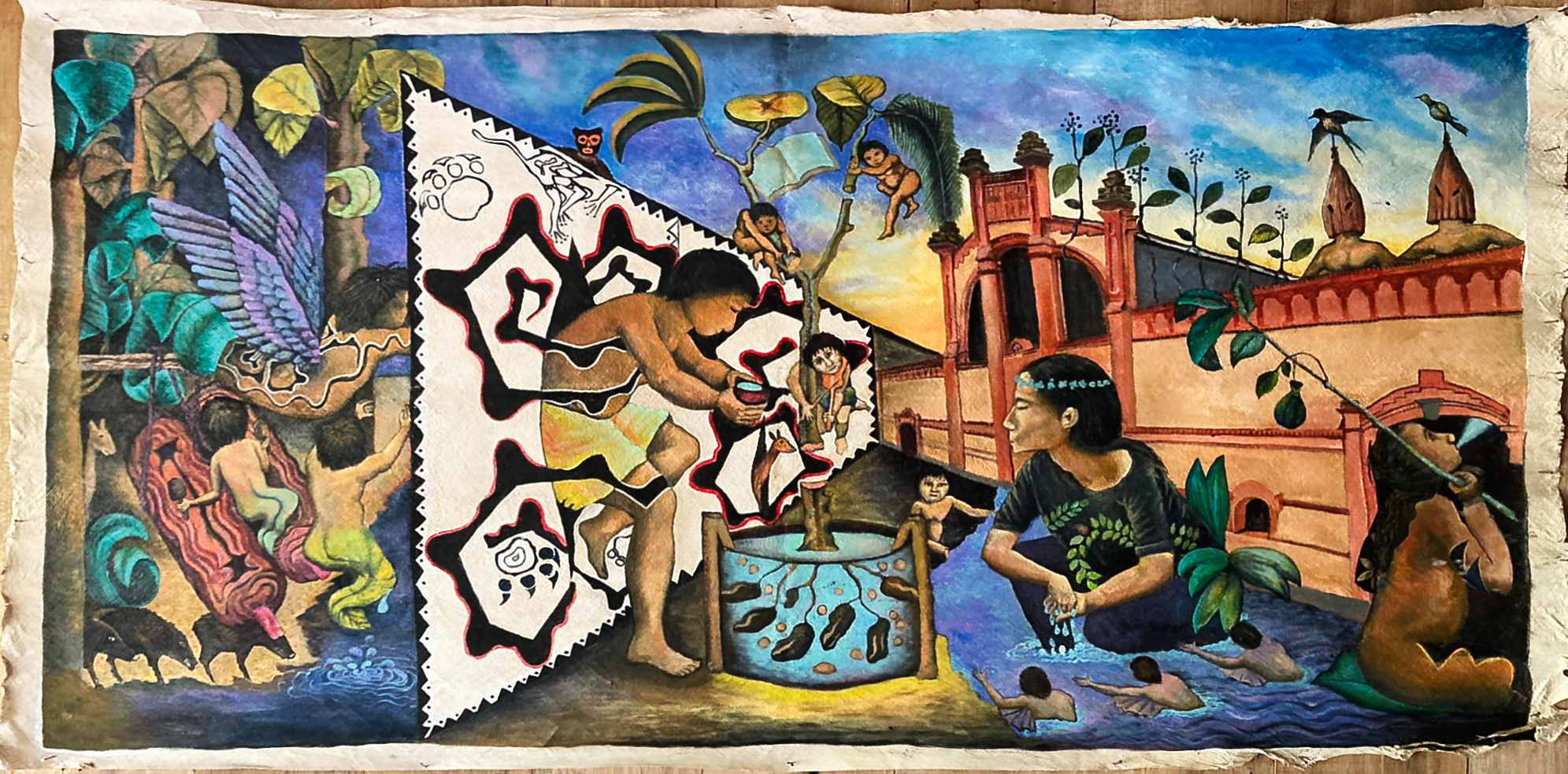
Brus Rubio, “Between Worlds”
The work alludes to the transition between the ancestral and the contemporary, between nature and the urban, the spiritual and the material. It weaves connections between times, worlds, and languages. It represents cultural continuity as a bridge between the invisible and the visible, between the memory of the forest and the challenges of the present. Contemporary Indigenous Art.
Voices Emerging from Silence — Expressions of Contemporary Indigenous Art
Indigenous artists themselves — and I know many personally — don’t always agree on the main message of their art. Instead, it’s a complex expression with many voices that powerfully shows what moves the Indigenous peoples of the Amazon. The loss of their land, culture, spirituality, ancestral knowledge, and identity is a central concern.
Ultimately, which aspect stands out in each work depends on the viewer and the moment of viewing, reflecting a variety of nuances and perspectives. In fact, this very diversity of voices and the lack of a single consensus are precisely what make this art so powerful. It’s a fragmentation that nourishes and enriches the Indigenous cultural universe.
Contemporary Indigenous art is not a single message or a homogeneous narrative. Instead, it’s both wound and healing, loss transformed into reappropriation, and memory reimagined. It’s also a blend of spirituality and political action. combining individual experiences with collective forces. This variety of perspectives and internal tensions is exactly what makes contemporary Indigenous art so powerful, authentic, and relevant.
Voices that whisper memories, heal wounds, and break the silence.
Contemporary Indigenous works unveil themes deeply linked to collective memory. They transmit ancestral stories and shared narratives that shape identity. At the same time, they express each artist’s individual voice: their personal history, experiences, and worldview.
This dialogue between the collective and the individual reveals a constant confrontation with the wounds of the past and present. This is particularly true for cultural separation, social exclusion, and the ongoing silencing of their voices.
Within this context, art becomes both resistance and healing. It serves as an act of vindication, a refusal of marginalization, and an affirmation of the right to respect, recognition, and belonging.
These works do more than address loss. They also serve as a pursuit of healing, an effort at rebuilding identity, and a projection of futures shaped by memory and dreams. Therefore, contemporary Indigenous art creates a space for critique and reflection—a convergence of voices that challenges dominant narratives and paves the way for cultural affirmation.
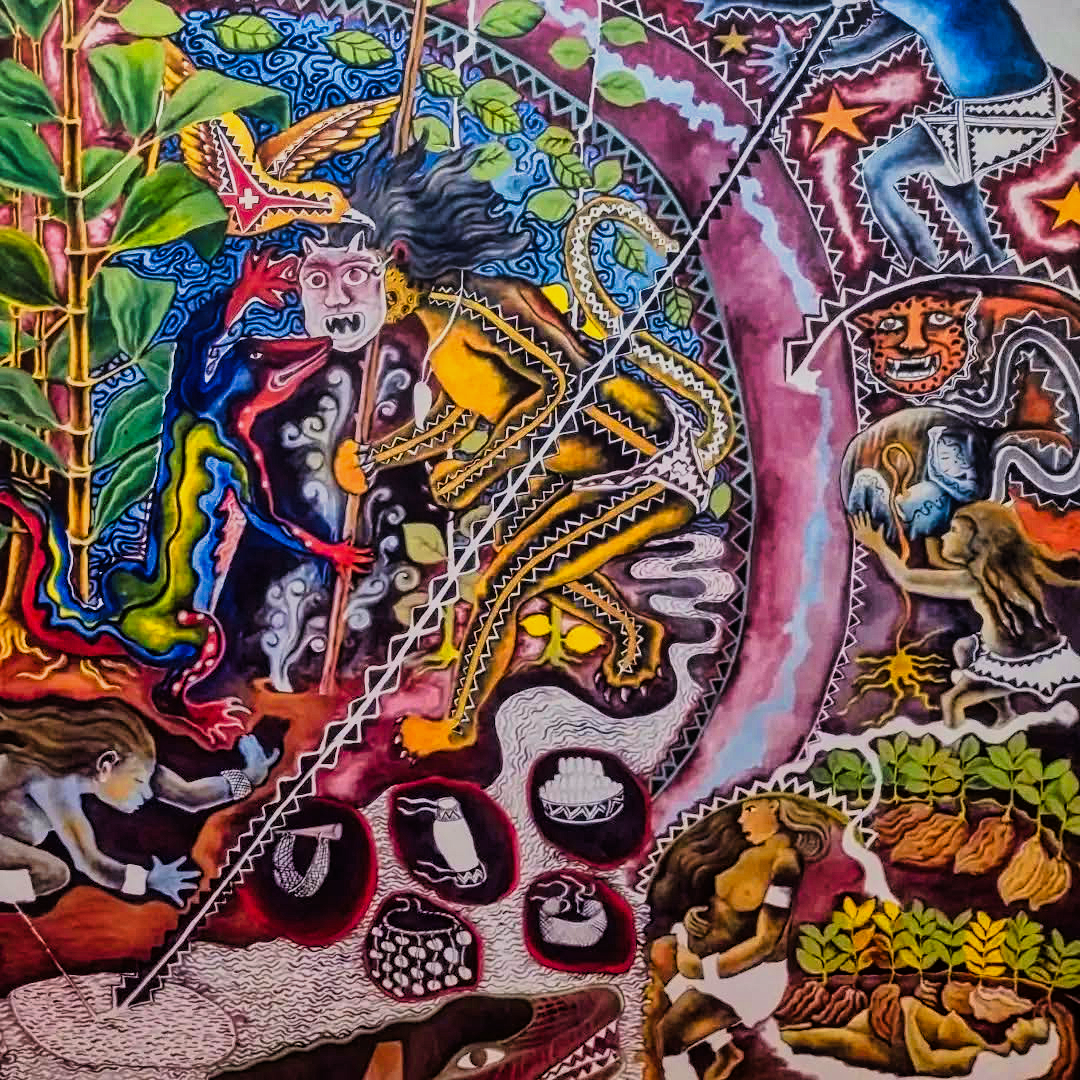
Brus Rubio,”El Laberinto”, Arte indígena Contemporáneo
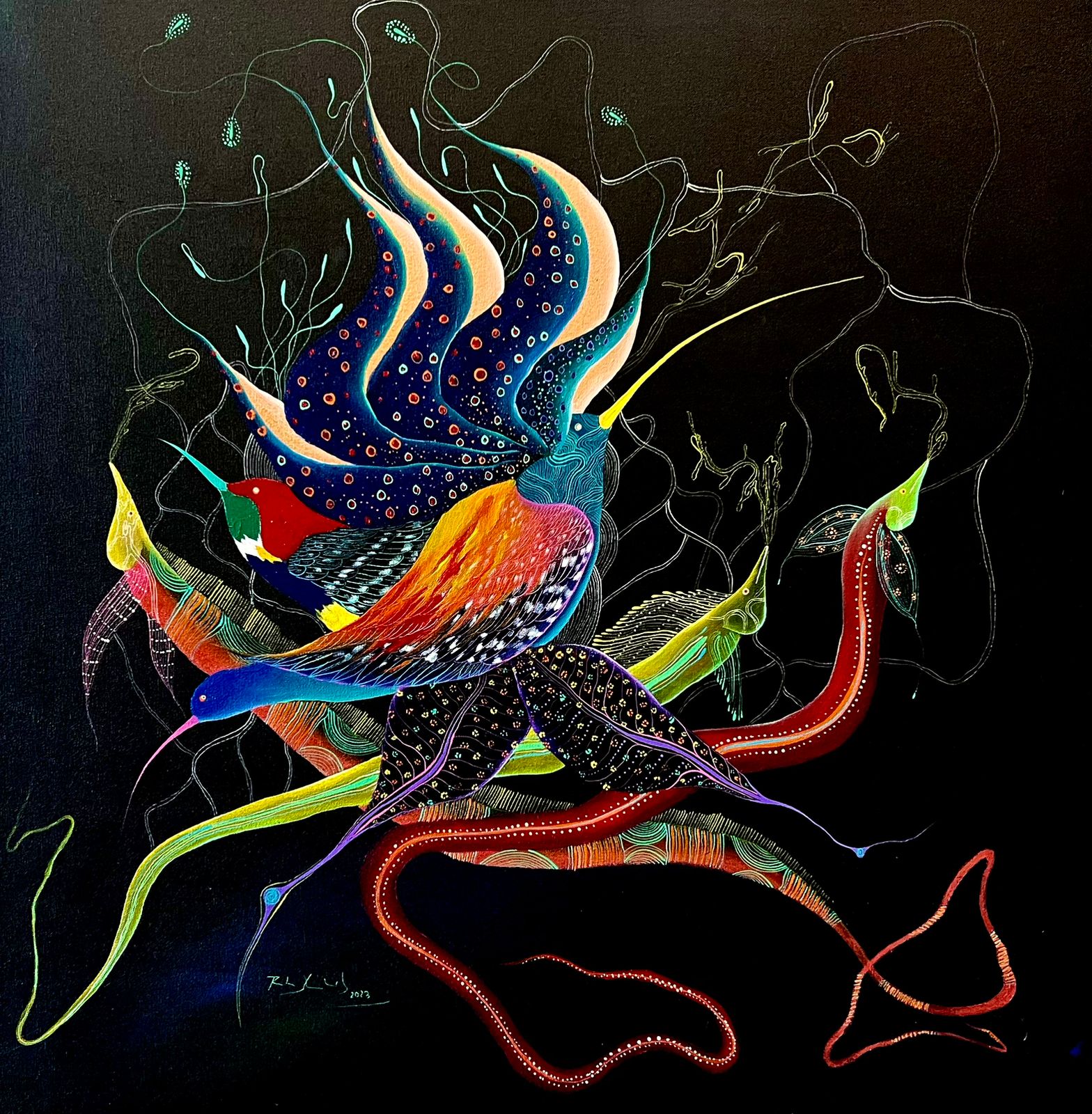
Rember Yahuarcani, Contemporary Indigenous art
The Future of Contemporary Indigenous Art: Challenges and New Voices
Territorial dispossession, environmental destruction, and cultural marginalization pose a serious threat. They endanger the continuity of traditional ways of life and the cultural identity of Indigenous peoples. It is not only their living environment that is affected, but also the cultural continuity and the spiritual foundation from which their art emerges.
And yet, this threat often becomes a powerful source of artistic motivation and inspiration.
Despite great challenges, Amazonian art is gaining increasing visibility. It is consolidating itself as a contemporary art form with its own voice—powerful, passionate, and constantly evolving.
Art that transforms perception
This art encourages us to explore different perspectives on the world. The time-honored wisdom of Amazonian peoples presents a view in which humanity is not separate from nature but part of it.
For millennia, Amazonian peoples have lived in reciprocity with their environment, honoring and respecting it. Their worldview offers a powerful inspiration for more sustainable ways of inhabiting the Earth, inviting us to rethink our relationship with the natural world.
As global awareness of the Amazon’s ecological and cultural importance continues to grow, so does interest in its distinctive artistic expressions.
The future promises a continued flourishing of both Indigenous and non-Indigenous voices. Each one contributes, in their own way, to a rich and ever-evolving narrative. It is the story of a region that is both ancestral and deeply contemporary.
Art does not explain the world — it transforms the way we see it.
It preserves memory, culture, and tradition; it reflects the present, creates spaces for knowledge, and becomes a place between worlds.
A space where wisdom is not only transmitted, but where a deeper connection becomes tangible.
Whether ritual or individual, spiritual or social, here we encounter stories that are not only told, but lived.
Contemporary Indigenous art often touches us where words fall short — in that invisible thread that connects humans, animals, plants, and spirits, and weaves a bridge between worlds.
An intangible yet present connection, extending like a web of experiences, myths, and dreams beyond the limits of the visible.
That bridge leads not only from the visible world to the invisible, but also from the past to the present, from collective experience to the individual soul.
It reaches us where words fall short and opens spaces where the rational meets the spiritual, and the material merges with the transcendent.
Amazonian art does not merely depict its world – it transforms origin, history, spirituality, identity, and worldview into forms that can be directly experienced. These unfold their meaning – becoming visible, perceptible, and tangible.
Epilogue: The Echo of Voices
In a world that so often silences, contemporary Indigenous art rises as a deep echo — one that breaks through the walls of loss and invisibility.
It is an act of resistance — proof that memory, identity, and spirit do not die, but are reimagined through the artist’s gaze.
This narrative, rich in nuance and contrast, invites us to listen beyond words, to see beyond images. Within that diversity lies the true strength of a people who do not surrender, and who, through art, continue telling their story.
An open story. A possible future.
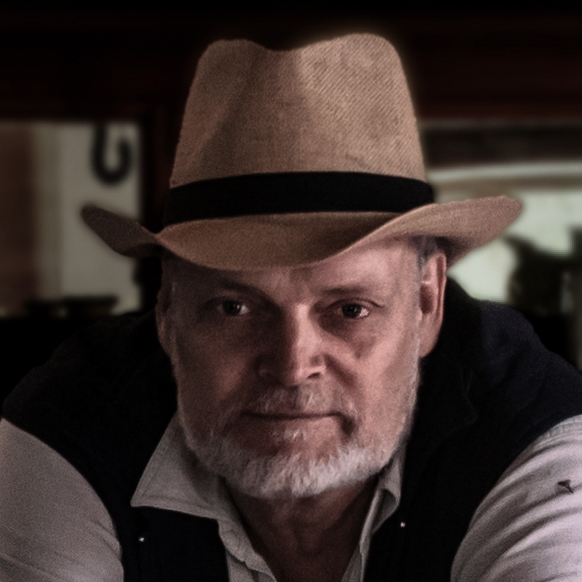
written by Rolf Friberg
